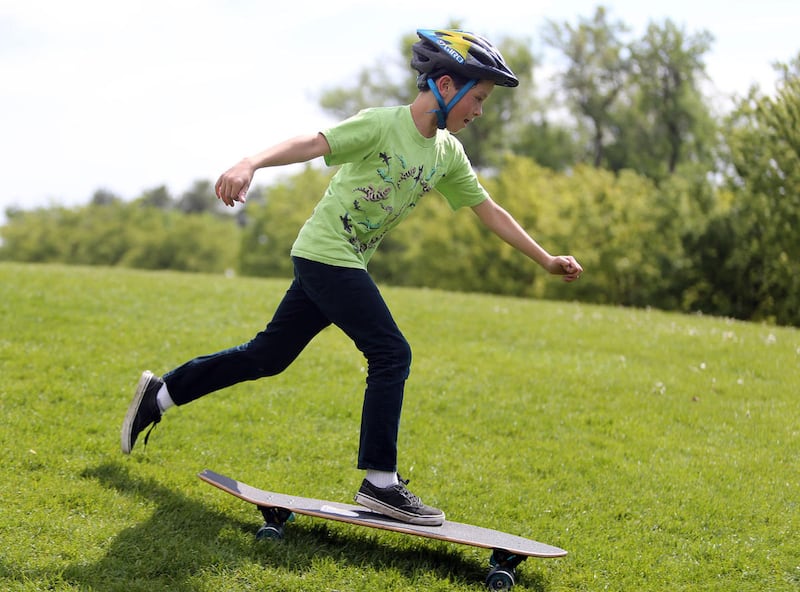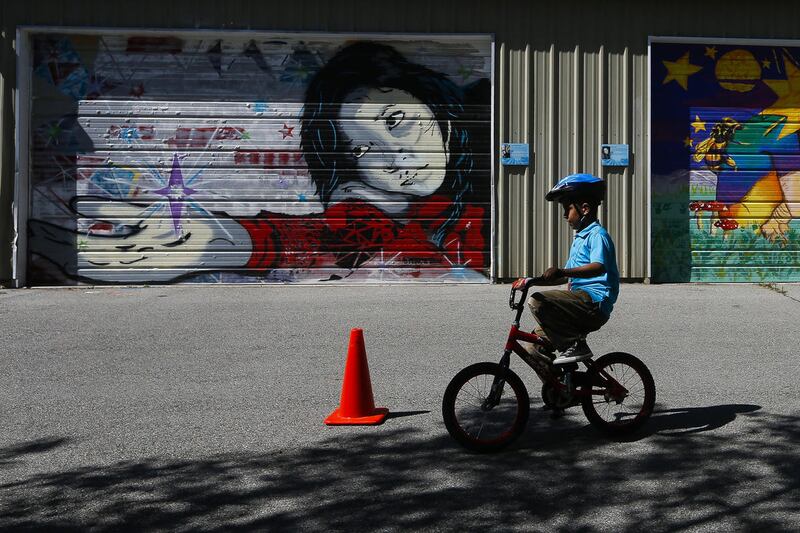Summer is the season of cookouts, camping and car trips. Kids will head outdoors to pools, lakes and skate parks, or go hiking or biking with families and friends. For children, the 100-day span between the Memorial Day and Labor Day weekends is largely about play.
For many others, including emergency room doctors, search and rescue teams and first responders, it's a time to gear up and get moving because summer has a dark side: It's a particularly deadly time of year, especially for kids who are more susceptible to motor vehicle crashes; drowning; skateboard, long board and bike-related injuries; and other calamities than at any other time of year.
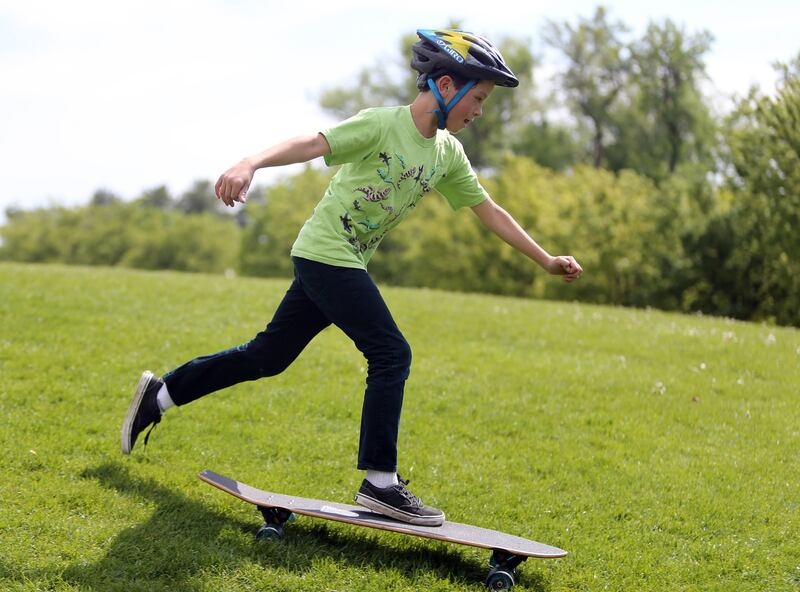
Nikolai Gold skateboards down a hill in Liberty Park in Salt Lake City on Monday, May 8, 2017. He is part of an after-school program for the Salt Lake Arts Academy called Skate or Die. | Kristin Murphy, Deseret News
Beauty and joy may attract injury and death.
Dr. Charles W. Pruitt, president of the Utah Chapter of the American Academy of Pediatrics and a pediatric emergency medicine physician at Primary Children’s Hospital, says when people head outdoors to enjoy summer's natural beauty and fun, they may forget about safety and not take proper precautions.
Motor vehicle crashes are, by far, the most deadly event for teens and children, and the all-ages death toll is nearly twice as high in summer, prompting a national "100 Deadly Days" campaign. In the United States, 2,333 teens ages 16-19 were killed and more than 221,313 were treated for injuries from crashes in 2015, the most recent year for which numbers are available, according to the Centers for Disease Control and Prevention. More than 1,600 children younger than 15 died in vehicle crashes.
Add the thousands who are severely injured or die by drowning, firearms, falls and in other ways, many of them related to recreation, and it's a season when experts say safety should top the to-do list.
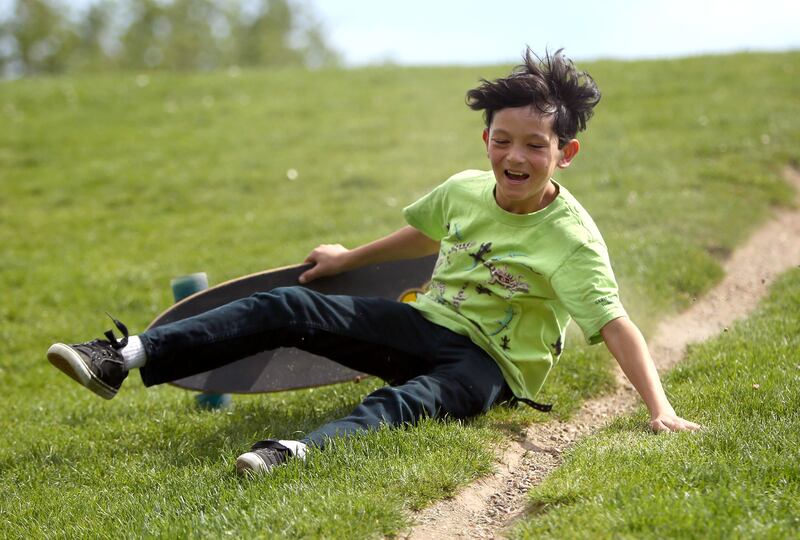
Nikolai Gold falls while riding down a hill on a skateboard in Liberty Park in Salt Lake City on Monday, May 8, 2017. He is part of an after-school program for the Salt Lake Arts Academy called Skate or Die. | Kristin Murphy, Deseret News
The good news is, parents have tools to keep their children safe. Prevention is a process built on routine, basic tools and simple steps.
Watchful eye
“As much as you can, do good monitoring,” is the advice for parents from Kimberly Myers, suicide prevention coordinator for Utah's Division of Substance Abuse and Mental Health.
She means monitor driving, drug and alcohol use, what kids are doing, where they’re going and who is with them. She means checking in on them personally and also watching them on social media.
“Make the environment as safe as possible,” she says. If kids get bored or curious, make sure you’re locking up things like alcohol and storing firearms safely with multiple layers of locks.
Younger kids need supervision. Older kids need a clear understanding of expectations and rules.
Children face a lot of risks in summer and each comes with specific things that parents can do.
In the water
Even before most schools let out for summer break, warm weather beckons families outside, but an unusually wet spring in Utah and some other parts of the country has prompted experts to warn parents about water dangers — warnings punctuated with real deaths involving children and adults.
Water is always potentially dangerous, but that's especially true when it's running high and fast. And children are very vulnerable.
"People need to be very careful around streams, rivers and lakes," says Jenny Johnson, a spokeswoman for the Utah Department of Health, who tells parents to stay within arm’s reach of a child who is near water.
Parents can take turns watching even a group of kids, but someone must be on duty as a “water watcher” at all times, she adds. “You can switch every few minutes so you can socialize, too. But pay attention and watch."
American Red Cross Utah-Nevada Communications Director Richard Woodruff says kids should learn to swim.
That won't guarantee safety around water any more than the presence of a lifeguard will guarantee it. Both are tools. Until kids can swim, don’t rely on water wings. Use life jackets and supervision.
Age and experience around water make a great difference. Older kids are more likely to get in trouble in lakes and reservoirs, usually when they are out with friends and family on a boat and overestimate their swimming prowess or the water temperature.

National Center for Health Statistics, National Vital Statistics Center Produced by National Center for Injury Prevention and Control, CDC | Alex Goodlett, Deseret News
”Sadly, our coroner says when he hears about a teenage drowning, he always knows the victim's wearing jeans," says Pruitt. "Teens take risks at a much higher rate. When one drowns, it's not typically at the pool in swim trunks with a lifeguard. Sometimes alcohol and drugs are involved. Or they challenge each other and think they can swim farther than they can.”
Younger children are more likely to drown in a pool or in a smaller body of water. If a child has wandered off from a campsite (or even at home), check water features first, every time, says Jessica Strong, Primary Children's child safety expert and community benefit and outreach manager. "Drowning happens so quickly.”
Drowning doesn’t look like what you’d expect, either. Drowning is usually silent and the person may look like he is simply bobbing in the water. An instructional video that accurately depicts drowning is noteworthy for its lack of drama and flailing and shouting, although someone who does those things probably genuinely needs help, too.
Anyone out on the water — any age, any skill level — should wear a life jacket, says Cambree Applegate, director of Safe Kids Utah. “People get comfortable or maybe they’re avid boaters, out on the water all the time and never had anything bad happen. I recommend it be worn at all times. You never know when a situation (on water) will change.”
Kiddie pools should be emptied after each use. Kids can drown in tiny amounts of water in some circumstances. Pruitt speaks sadly of a child who had a seizure and drowned in a bowl of soup.
On the road
Vehicle fatalities don’t occur when people think they do. Nearly 6 in 10 crashes occur during daytime and more than 83 percent are on dry roads.
The factors most often involved in vehicle fatalities are not using seat belts; drivers who are alcohol/drug impaired; aggressive driving; motorcycles; pedestrians; and drowsy driving and distracted driving, which are about equal. Bicycles are involved in a small portion of vehicle crashes. Any death could involve more than one of those factors.
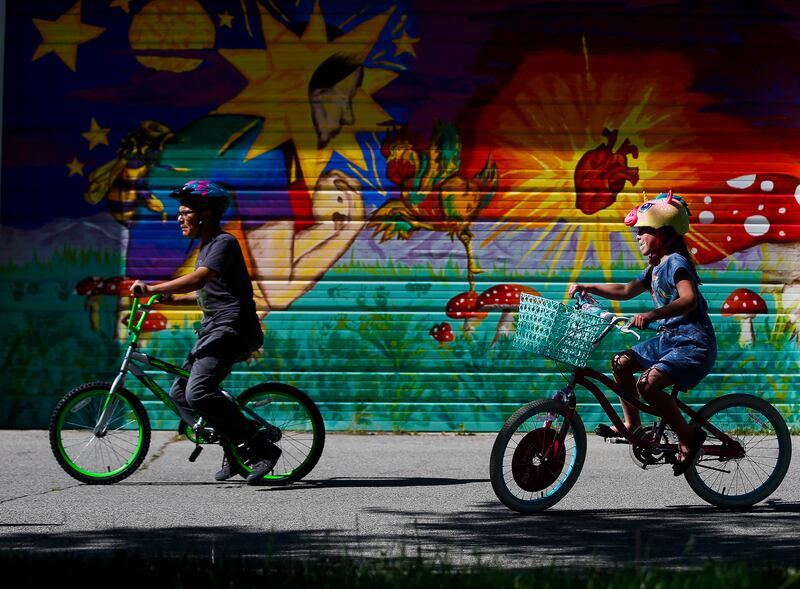
Ezequel Verdin and Trinity Condie participate in the Bike Rodeo at Neighborhood House in Salt Lake City on Wednesday, May 10, 2017. The event was held in celebration of Bike to School Day and helped children learn proper bike safety in preparation for the summer months. | Alex Goodlett, Deseret News
Driving with children can be distracting, even annoying. "Children can be loud and excited and just being kids, which is distracting," says Pruitt. "I would encourage any driver to relax, take a deep breath and focus on driving even when food and projectiles are flying around.”
Seat belts save lives and prevent injuries in crashes, he notes. "Make sure everyone is properly restrained in the vehicle and in the proper car seats or booster seats or seat belts. Make sure they are in the proper part of the vehicle," which means children, he notes, belong in the back.
Johnson says wearing a seat belt is supposed to be the norm, but a lot of teens don’t wear them when their parents aren’t around. Teenagers are more apt to wear seat belts when they’re alone and not with friends.
Too many times, says Amy Winkler, a highway safety specialist with Utah’s Department of Public Safety, teens don’t think about safety. They don’t buckle up. Or they pile into a car with more kids than there are seat belts, which can be disastrous.
Before a friend holds someone on her lap, consider this: The weight of the occupant multiplied by the speed the vehicle is traveling is how much restraining force is needed to hold someone in place.
Even low-speed crashes can be deadly. In 2010, Utah college student Chelsie Hill was thrown through the sunroof and killed when the vehicle she was in was clipped at 5 mph by another vehicle.
In summer, as families take road trips, kids sometimes fall asleep and their parents let them unbuckle or put the shoulder part of their seat belt behind them so they’ll be more comfortable, says Winkler. “Don’t,” she says. “You never know when a crash is going to occur. Put your belt on properly."
A teen who rides with his or her feet on the dashboard can be badly injured if the airbag deploys. It’s important to sit properly, feet on the floor. To improve comfort, take a pillow to snuggle, she says.
Use restraints properly, she says:
— A seat belt should cross the clavicle, while the lower belt sits low on one’s lap.
— A child safety seat must be the right size. At the U.S. Department of Transportation's safercar.gov, parents can input weight and height to determine which size is best. The seat must be properly locked, the seat belt holding it tight so it doesn’t move more than an inch. The harness should be snug against the child. The chest clip should be at armpit level.
Other wheels
Nationwide, every hour, about 50 children visit emergency departments for injuries resulting from bikes, scooters, skateboards or skates. They include serious head injuries and lots of fractures. Four in 10 kids, ages 5-14, don’t wear helmets each time they do the four wheeled sports, according to the Safe Kids organization. About one-third of bicyclists in a crash wore a helmet.
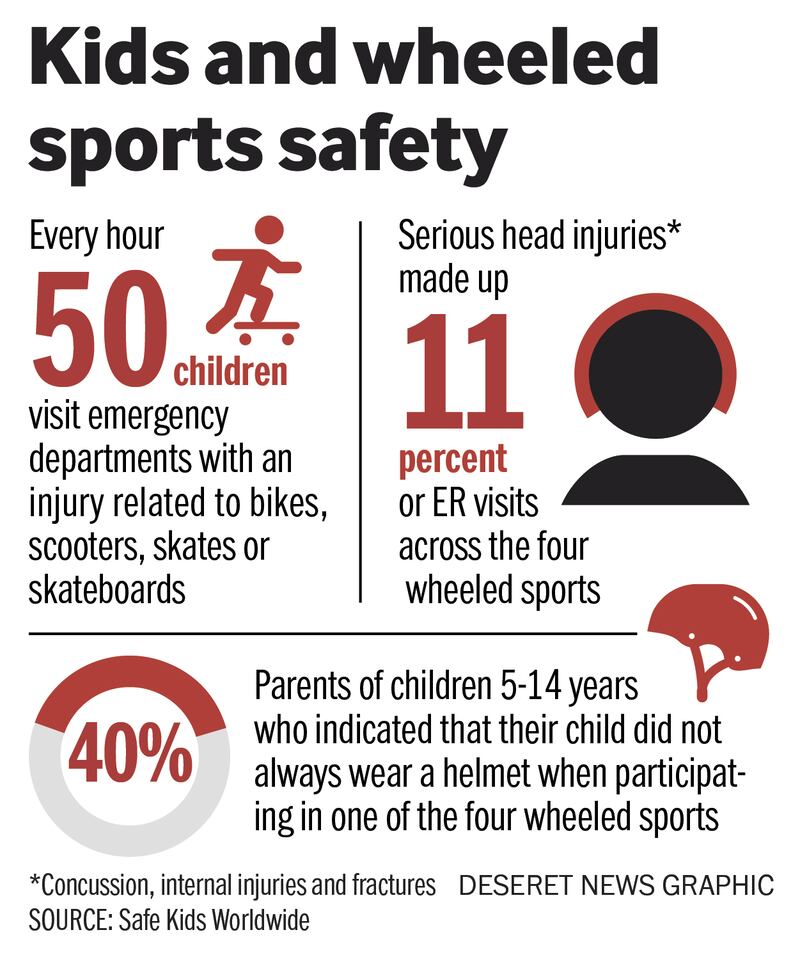
The organization says 98 kids died riding bicycles in 2014, but nearly a quarter million needed emergency department care. More than 26,000 were treated for related traumatic brain injuries. Meanwhile, 84,000-plus children were injured skateboarding and another 59,300 were hurt skating.
Pruitt thinks the number of such injuries could be pared back with the right message. The influence of children's idols is a potential tool.
“Ride like the pros" is how he puts it. People should gear up like the professionals on bikes and boards of all kinds. Pros know helmets save their lives, so they wear them.
Keeping the helmet handy helps. If a kid has to hunt for it in the house, she might forgo it. If the helmet and other safety gear is with the bike, the scooter or the skateboard, odds improve, Johnson says. In 2012, of 30 skateboarders who died, only two wore helmets. All were male; half were children, most were teens.
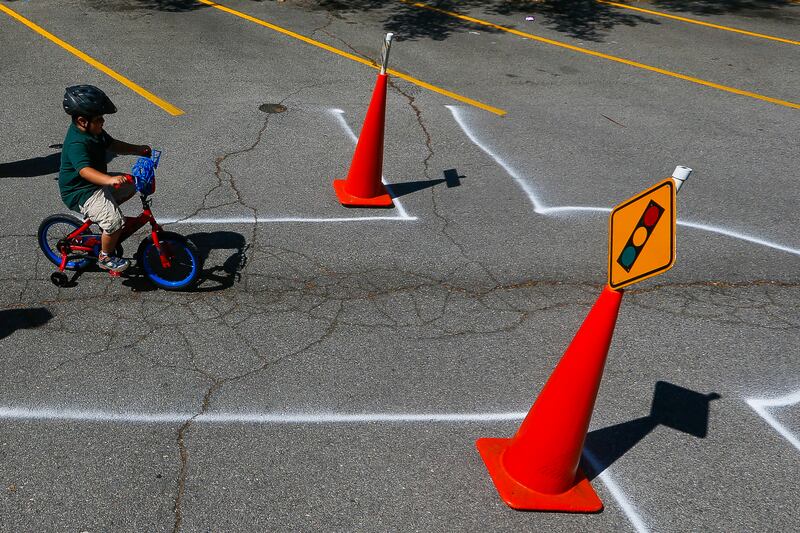
David Osorio participates in the Bike Rodeo at Neighborhood House in Salt Lake City on Wednesday, May 10, 2017. The event was held in celebration of Bike to School Day and helped children learn proper bike safety in preparation for the summer months. | Alex Goodlett, Deseret News
If parents insist on helmets — and always wear them themselves — children are much more likely to use them.
One of the biggest reasons kids get hurt while not wearing helmets or seat belts is parents don’t always insist. They figure they’re close to home, or just going a short distance. What could go wrong? The cost in human capital — injuries, death, suffering, health care costs, lost wages and more — makes it a multibillion-dollar question.
On your feet
Pedestrian injuries and deaths are on the rise nationwide.
A Zero Fatalities video produced for the Utah Department of Transportation and the Department of Public Safety shows the difference between pedestrians wearing reflective gear and those who aren’t. Kids and adults alike overestimate how well they can be seen. In the video, at 100 feet, a group of runners are finally visible, and to avoid hitting them, a car would have to be going slower than 25 mph.
It’s a visually stunning look at how invisible people are — even wearing white — when it's dark.
“I think kids and parents don’t understand how big of a deal the visibility issue is,” says Marques Varela, Vulnerable Roadway Users Program manager for Utah’s Department of Public Safety. “It takes quite a bit of either light or someone having reflective stuff on for drivers to not only see but actually recognize someone as a pedestrian.”
Most often in crash investigations, officials find the driver took action too late because he didn’t recognize what he was seeing at first.
Anyone not wearing an actual light or something “really, really reflective” must assume drivers don’t see them, he said.
The second issue is right of way. Having it doesn’t mean a driver will see or respond appropriately.
Varela said, “By and large, people assume since they can see headlights of the car, they are being seen by the driver.” It may not be true.
Kids often cut between crosswalks to save time. They don’t wait for lights but try to dodge traffic. They are distracted by friends, technology and other factors, putting themselves in danger.
It’s a poorly understood fact that hitting a crosswalk button not only causes a signal that is supposed to alert drivers but it also adds a few extra seconds so that pedestrians can cross, Varela added.
Flames and heat
Emergency departments treat kids who’ve been left in hot cars. They cool down children who have heat stroke and heat exhaustion. They see burns from campfires, barbecues and fireworks, Pruitt says.
Things that are hot are not always kid-friendly.
Every year, children die after being left in a car in the heat, according to KidsandCars.org. It’s like being in an oven. That can even occur in cool months because cars become hot if the sun beats on the window, even when the temperature is low. Cracking the window isn’t the answer. Never leaving a child in a car is the answer.
“We unfortunately have incidents every year, whether the child dies or not,” says Johnson. Some of the survivors end up with brain and organ damage.
The most common reason young kids are left in a car is a change in routine, such as taking the baby to day care when your spouse usually does it. Some experts suggest leaving a purse or shoe you'll need in back with the child. You'll see the baby when you retrieve the other item you need.
Children also sometimes hop into unlocked cars and get trapped. So lock the doors when you park.

Dylan Tafoya participates in the Bike Rodeo at Neighborhood House in Salt Lake City on Wednesday, May 10, 2017. The event was held in celebration of Bike to School Day and helped children learn proper bike safety in preparation for the summer months. | Alex Goodlett, Deseret News
Hydration’s critical during hot-day activities to combat heatstroke and exhaustion. Don’t overeat, which revs metabolism. Dress appropriately in clothing that breathes, use the right degree of sunscreen and reapply it often. Parents can proactively apply those tips to young kids and as they grow they will know what they need to do, says Woodruff. He also recommends apps from the American Red Cross that cover help in first aid and disasters.
Fireworks and skin are not a good mix. Sparklers burn at 1,200 degrees Fahrenheit, says Applegate. To avoid potential for injury of small kids, Applegate recommends forgoing sparklers in favor of glow sticks. Other precautions include having water around so a fire can be put out immediately.
"Fireworks don't always work the way they're supposed to. Sometimes they explode when they're not supposed to. Mostly we treat eye injuries and hand and face burns. Thankfully, it seems like we used to see more serious injuries with fireworks,” Pruitt says.
Kids should never be allowed to play around barbecues or campfires, where a loss of footing or balance spells disaster. For home grills, Applegate says to use the right tools and make sure nothing is around to catch fire.
Burns can be life-altering even if they’re not deadly, Pruitt adds.
“Make sure you have a mindset of preparedness,” says Woodruff. ”It matters."

